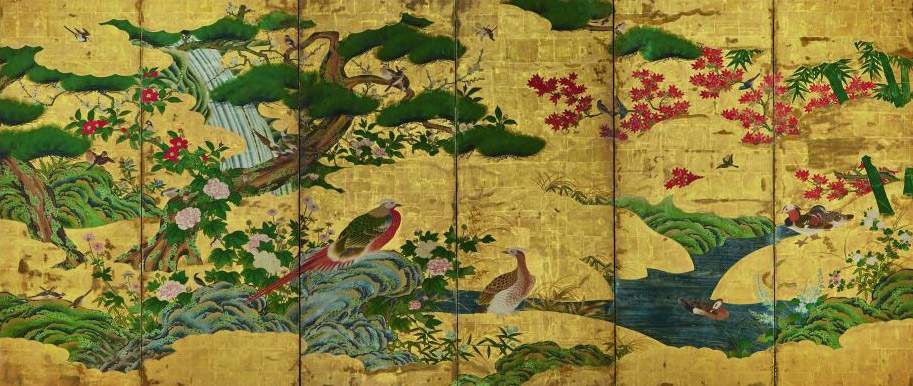Japanese Renaissance on display at the Uffizi: a unique exhibition
From Oct. 3, 2017, through Jan. 7, 2018 , theUffizi Gallery in Florence is showcasing "The Japanese Renaissance. Nature in Screen Paintings from the 15th to the 17th Century. "Curated by Rossella Menegazzo in collaboration with Asaka Hiroshi and Watada Minoru, the exhibition showcases 39 Japanese paintings depicting landscapes or natural vistas, large-scale paintings made on large-scale screens. This is the first time in Europe to witness such an exhibition. However, this is not the first time ever that Japanese art has been discussed in Florence: in 1967 the Gallery hosted an exhibition of Ukiyo-e (the famous prints on paper) from the early period (from the 17th to the 19th century), and in 2012 it was the turn of an exhibition on Japanese works from the Medici collections, which was held in Palazzo Pitti.
Today’s Uffizi exhibition, however, is something new and different, as director Eike Schmidt reminds us: "Today it is once again the Uffizi that offers the public the wonders of the Rising Sun, with an exhibition that has an unusual structure - admirably conceived and curated by a specialist such as Rossella Menegazzo - and that we will have to visit several times. These are in fact very fragile screens and sliding panels, many of them rarely seen even in Japan because they are jealously preserved in temples and collections, which will be displayed in rotation of thirteen at a time, to protect their preservation from exposure to light."
Inparticular, the works on display come from the golden age of Japanese painting, between theMuromachi era and the beginning of theEdo era (between the 15th and 17th centuries). The Japanese art that can be appreciated in the exhibition is basically divided between two currents: one is monochrome painting made of voids and lines, which links Chinese tradition with Zen philosophy, while the other is an indigenous painting, with gold backgrounds and flat color fields, suitable for decorating aristocratic homes and castles.
Again, in the exhibition we will have on the one hand artists such as Hasegawa Tohaku, Kaiho Yusho and Unkoku Togan, with their landscape works with rarefied and symbolic atmospheres, while on the other hand we have the Kano and Tosa traditions with works having as subjects flowers, birds, the four seasons and places that have become famous thanks to literature and poetry, represented by bright colors following the yamatoemode .
The event is organized in collaboration with theJapan Cultural Affairs Agency and with the support of theEmbassy of Japan in Italy and concludes the activities of the commemoration of the 150th anniversary of friendship between Italy and Japan.
The exhibition, stresses the Japanese Ambassador to Italy, Katakami Keiichi, "exhibition is a worthy conclusion to the initiatives celebrating the 150th anniversary of Japan-Italy relations, which have been going on since last year. Its title, The Japanese Renaissance, is not only a reference to the theme of the exhibition, but expresses the desire to take a new step forward into the future, building on the solid relations built in the one hundred and fifty years since the establishment of diplomatic relations between the two countries."
The exhibition can be visited at the Magliabechian Hall of the Uffizi (entrance from the Magliabechian Staircase) during museum opening hours (Tuesday through Sunday from 8:15 a.m. to 6:50 p.m.). Tickets: full 12.50 euros, reduced 6.25 euros for EU citizens between 18 and 25 years old, free for children under 18 of any nationality, disabled and accompanying persons, journalists, teachers and students of Architecture, Conservation of Cultural Heritage, Education Sciences, Bachelor of Arts and Philosophy degree with archaeological or historical-artistic majors, Bachelor’s degree or corresponding courses in the member states of the European Union, Italian teachers with fixed-term and open-ended contracts in service at a public or equal school in the country. Guided tours for schools, by reservation only, at a cost of 3 euros per pupil. Catalog published by Giunti. Info at www.gallerieuffizimostre.it.
Image: Kano School (copy from original by Kano Motonobu dated 1550), Birds and Flowers of the Four Seasons (early 17th century - Edo period, the original painting is from 1550, Muromachi period; Pair of six-panel screens, ink, color and gold leaf on paper, 152.9 x 349 each screen cm; Osaka shiritsu bijutsukan - Osaka Municipal Museum of Art)
 |
| Japanese Renaissance on display at the Uffizi: a unique exhibition |
Warning: the translation into English of the original Italian article was created using automatic tools. We undertake to review all articles, but we do not guarantee the total absence of inaccuracies in the translation due to the program. You can find the original by clicking on the ITA button. If you find any mistake,please contact us.





























